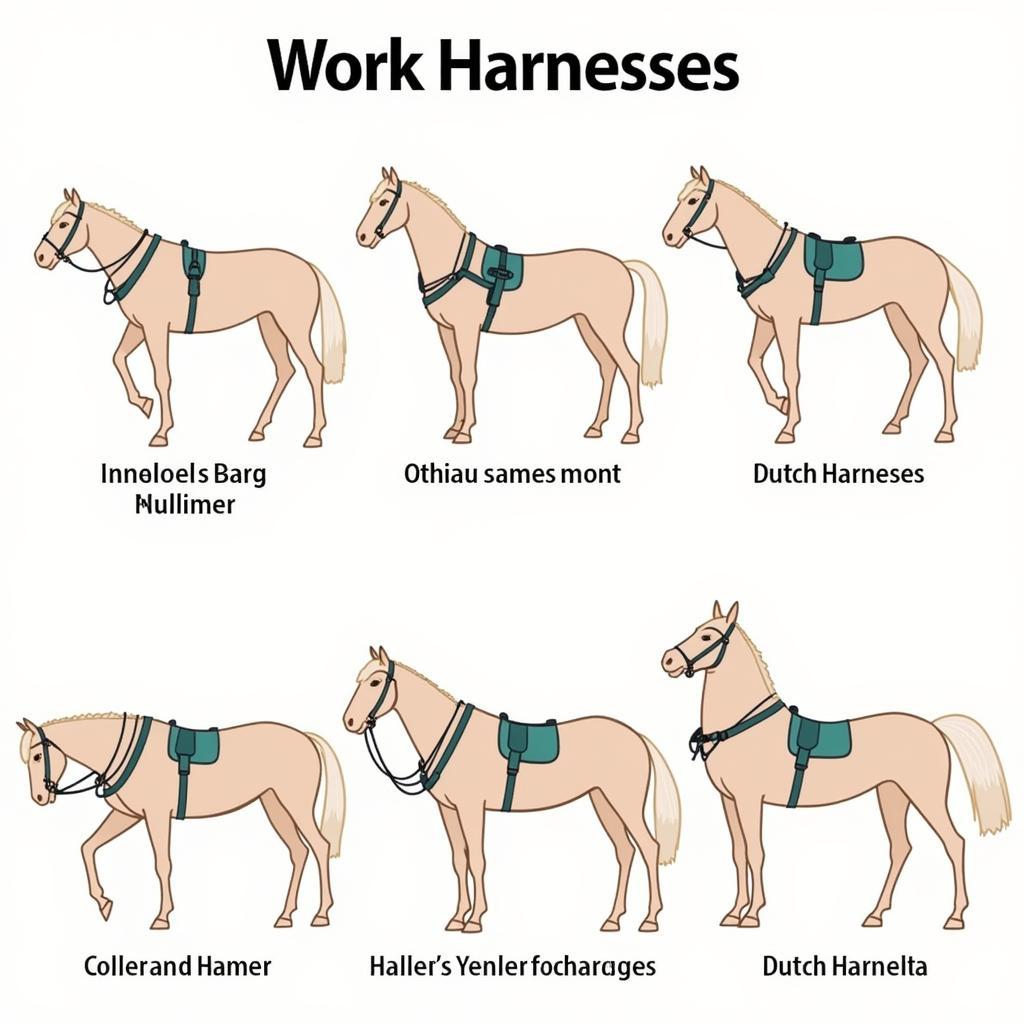A Work Harness For Horses is a crucial piece of equipment for any horse owner involved in driving or draft work. Selecting the correct harness ensures both the horse’s comfort and safety, and maximizes their working efficiency. This guide will cover everything you need to know about choosing and using a work harness for your equine partner.
 Different Types of Work Harnesses for Horses
Different Types of Work Harnesses for Horses
Understanding the Different Types of Work Harnesses
Several types of work harnesses exist, each designed for specific tasks and horse conformations. The most common types include:
- Breastcollar Harness: Often used for lighter work, this harness distributes the load across the horse’s chest and shoulders. It’s a popular choice for pleasure driving and lighter agricultural tasks. It’s a simple design and relatively easy to fit.
- Collar and Hames Harness: This is the traditional harness for heavy draft work. The collar and hames distribute the weight across the horse’s shoulders and neck, allowing them to pull heavier loads more efficiently. Proper fit is essential to prevent injury. Check out our pulling collar for horses for more information.
- Dutch Harness: This harness features a breastcollar and traces, often preferred in Europe, particularly for carriage driving. It offers a combination of comfort and control, making it suitable for a variety of tasks.
Choosing the right type depends heavily on the type of work the horse will be performing and their individual build.
Key Considerations When Choosing a Work Harness for Horses
When selecting a work harness for horses, several factors must be taken into account to ensure a proper fit and optimal performance.
Proper Fit and Adjustment
A well-fitted harness is crucial for the horse’s comfort and safety. A poorly fitted harness can cause sores, rubs, and restrict movement. Ensure the harness fits snugly but not too tight, allowing for a full range of motion. Key areas to check for proper fit include the breastcollar, traces, back strap, and breeching.
Material and Quality
Work harnesses are typically made from leather or synthetic materials. Leather is known for its durability and traditional look, while synthetic materials offer greater affordability and ease of maintenance. High-quality hardware is essential for strength and longevity. Consider a leather horse driving harness for a classic and durable option.
Intended Use
The type of work the horse will perform significantly influences the harness choice. Lighter tasks like pleasure driving may require a simpler breastcollar harness, while heavier draft work demands the robust support of a collar and hames harness. Consider the terrain and the weight of the load the horse will pull.
Horse Conformation
Each horse has a unique build, and the harness must be adjusted to accommodate their individual conformation. Take into account the horse’s size, shape, and any specific physical characteristics that might require adjustments to the harness.
Maintenance and Care of Your Work Harness
Maintaining your work harness properly will extend its lifespan and ensure the horse’s safety. Regularly clean and condition leather harnesses to keep them supple and prevent cracking. Inspect all parts of the harness for wear and tear, paying close attention to stitching and buckles. Proper storage in a dry, cool place is also essential.
What type of harness is best for plowing?
A collar and hames harness is typically the best choice for plowing.
How do I adjust a work harness?
Adjustments should be made in small increments until the harness fits snugly but comfortably.
Conclusion
Choosing the right work harness for horses involves careful consideration of various factors, from the type of work to the horse’s individual conformation. Investing in a quality harness and maintaining it properly is crucial for both the horse’s well-being and the efficiency of the work being performed. Remember a comfortable and correctly fitted work harness for horses is essential for successful work. For Tennessee horse owners, check out our horses for sale tn listings.
FAQ
- What is the most common type of work harness?
- How do I know if my harness fits correctly?
- Can I use a breastcollar harness for heavy work?
- How often should I clean my leather harness?
- What are the signs of a worn-out harness?
- What materials are work harnesses made from?
- Where can I buy a high-quality work harness?
Common Scenarios and Questions:
- Scenario: A beginner horse owner needs a harness for light pleasure driving.
- Question: What type of harness is recommended for a beginner, and how do I ensure it fits my horse correctly?
- Scenario: A farmer needs a harness for heavy fieldwork with a draft horse.
- Question: What’s the best type of harness for heavy draft work, and how do I maintain it properly?
Further Reading and Related Topics:
- You might also be interested in our article on bute less for horses.
- If you’re looking for equipment for other tasks, consider our iron horse air compressor.
When you need help, please contact Phone Number: 0772127271, Email: [email protected] Or visit our address: QGM2+WX2, Vi Trung, Vi Thuy, Hau Giang, Vietnam. We have a 24/7 customer support team.